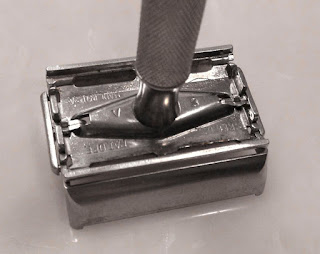I'm still a bit fuzzy myself about the first RT, the Milord, in that it's sometimes listed as a 1940 and not 1941 like the RT that was scheduled to be released, in nickel plating, for Christmas 1941...
Yeah, I still haven't gotten anything concrete about that brass head.
After World War 2, Gillette resumed civilian production and released the 1946 RT, removing the patent info from the smooth band above the TTO knob (placing it under the center bar) and adding end caps.
A gold-plated Milord model was also offered...
Gillette was known to swap parts and used them on other models, which led to a hybrid of sorts in 1947. The uncreased baseplate head was mated to the standard Super Speed handle that lacked the smooth band...
1947 production used the creased baseplate; but something odd occurred, and I've run into a dead end. Some '47s had a flat shoulder milled into the handle, just below the neck...
...while others didn't...
I've only seen the Milord with the flat-shouldered handle.
For 1948, Gillette redesigned the center bar, giving it notched ends to facilitate loading of blades from their quick-load dispensers. The only real difference between the 1948 and 1949 models were the case, with the 1948 coming in a cardboard box, as in the previous year, and a red plastic case for 1949...
(Images courtesy mr-razor)
And, as with the previous models, the 1949 came in the gold-plated Milord (not really sure if there was a 1948)...
Now, as we learned in Super Speed 101, the patent info under the center bar read "PAT. NOS.ON PACKAGE" through 1949, and was changed to "PAT. NOS. ON PKG." beginning in 1950. There were also no date codes up to this point...with one exception: the V3.
There are two variants of the V3, one where the stamp is upside-down in relation to the rest of the markings, and another...
...where they're right side-up. The V3 was produced during the third quarter of 1950. The rest of that year's production had no date code. The V3 was supposed to be a "test" code, but it makes on wonder...why only July, August, and September? Why not continue through the end of the year?
(Revised patent info)
Gillette officially
began date-coding their razors in 1951, W1. 1951 also saw the "black tip" Super Speed (giving a "regular" shave; more on the colored-tipped razors later), one with a steel handle (pictured with the "mild" blue-tipped Super Speed)...
...and one with an aluminum handle (both were made during the Korean War, and reduced the use of brass needed for shell casings). Three known different TTO knobs exist: plastic, steel, and brass (a tan tip supposedly exists as well, but may be just an urban legend).
These Super Speeds are known as "40s style", and ended with the 1954 Z3 and Z4 "TV Special", which included a unique blue case...
(Image courtesy mr-razor)
1954 also ushered in the era of the "flare-tip", an improved (some say) TTO knob and knurling on the handle...
Back to the color-coded tips: The unfinished tip was advertised and "regular", the blue-tip was "mild", and the red-tip for "heavy", tough beards. The different levels were defined by the blade gap, or exposure, for varying degrees of aggression.
A second "TV Special" came out in 1958, with the absence of horizontal grooves on the handle, and coming in a red case similar to the 1954 model.
Note: The band just above the TTO knob is slightly narrower from previous models. This continued through 1966-67 when Gillette changed over to the black-handled models...
...which morphed into the "waffle" pattern in 1980...
And lastly (as far as I know), somewhere along the way, head geometry changed as well.
(L-R: 1956, 1961, 1973)
The heads on later models became slimmer, and the razors milder. (It should be noted here that these are the "Made in USA" models only; not mentioned are the English "Rockets" or those made under license in other countries.) Weight was reduced as well. Gillette stopped production of the Super Speed in 1988, a run of 41 years. And considering the condition of the older razors still out in circulation, I'd say Gillette made a pretty damned good razor.























With Razor Growth, my stubble turned into a full beard. Completely worthwhile
ReplyDeleteRazor Growth
Outstanding digital marketing firm—shrewd targeting, data-driven choices, and consistently polished communication.
ReplyDeleteRazor Growth